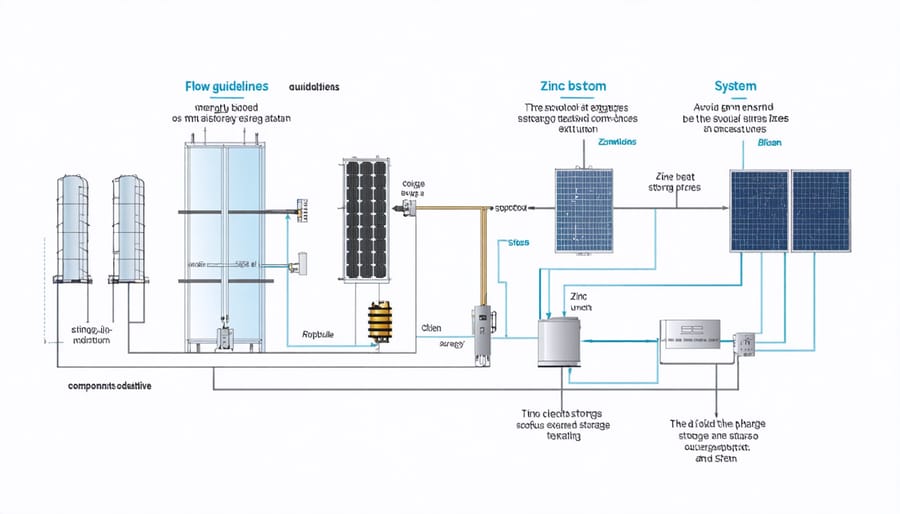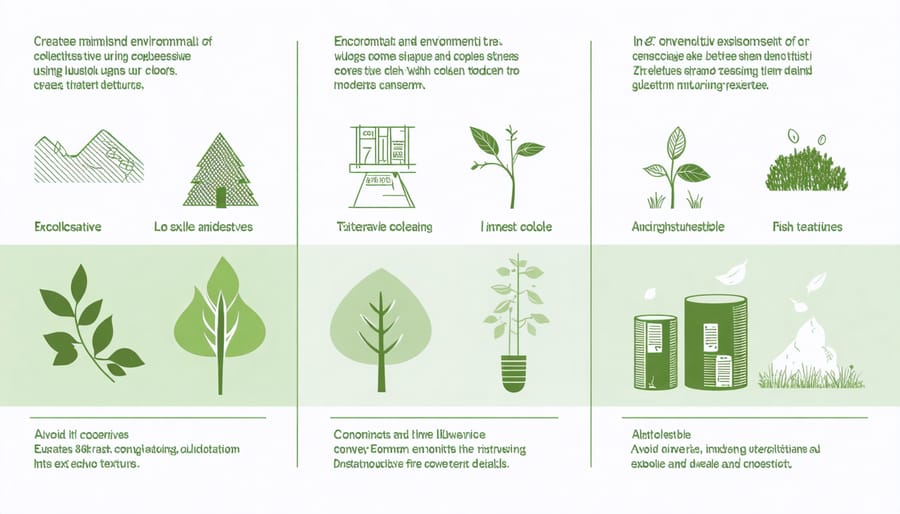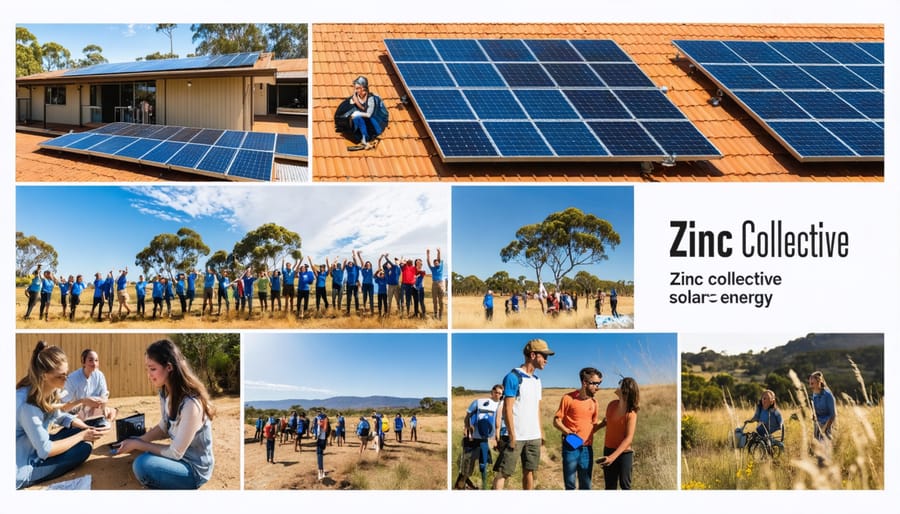In the sun-drenched landscapes of Australia, a revolution in community solar power is taking shape through the Zinc Collective – a groundbreaking approach that combines cutting-edge zinc-based energy storage with neighborhood-powered solar initiatives. This innovative model has already transformed energy consumption patterns across regional communities, from Byron Bay to Adelaide, reducing electricity costs by up to 40% while strengthening local energy resilience.
Unlike traditional solar installations, the Zinc Collective harnesses the power of zinc-air battery technology, offering a safer, more sustainable alternative to lithium-based storage systems. What makes this approach truly revolutionary is its community-driven framework, where residents pool resources to create decentralized power networks that benefit entire neighborhoods.
As climate challenges intensify and energy costs soar, the Zinc Collective represents more than just an energy solution – it’s a blueprint for community-powered sustainability that’s uniquely suited to Australia’s abundant solar resources and strong community spirit.
What Makes Zinc Collectives Different?
The Science Behind Zinc Energy Storage
At the heart of modern community solar storage solutions, zinc-based energy storage technology is revolutionising how we capture and store renewable energy. Unlike traditional lithium batteries, zinc-based systems offer a safer, more abundant, and environmentally friendly alternative for energy storage.
The science is remarkably straightforward: zinc batteries use zinc metal as the anode and air as the cathode, with an electrolyte solution in between. During discharge, the zinc oxidises (combines with oxygen), releasing electrons that generate electricity. When charging, this process reverses, making it a highly efficient and recyclable system.
What makes zinc particularly attractive for Australian conditions is its stability at high temperatures and its non-flammable nature. The technology can withstand our harsh climate while maintaining consistent performance. Additionally, zinc is abundant in Australia, making these storage solutions more cost-effective and sustainable than imported alternatives.
The system’s ability to scale from small household units to large community installations makes it incredibly versatile for different energy storage needs. This flexibility, combined with zinc’s inherent safety features, positions it as a game-changing technology for our renewable energy future.

Community-Driven Energy Solutions
Zinc collectives are revolutionizing the way communities participate in renewable energy by creating accessible pathways for shared ownership and decision-making. Through these innovative community-driven renewable energy initiatives, residents can pool their resources to invest in solar installations and energy storage systems. This collaborative approach not only makes renewable energy more affordable but also ensures that the benefits are distributed fairly across the community.
Local groups in regional Australia are already demonstrating the power of this model, with neighborhoods coming together to establish shared solar farms and battery storage facilities. These collectives enable participants to reduce their energy costs while contributing to their community’s sustainability goals. The zinc collective model particularly benefits those who might otherwise be unable to access renewable energy solutions, such as renters or residents of apartment buildings, creating a more inclusive clean energy future for all Australians.
Success Stories from Australian Communities
Rural Success: The Broken Hill Project
In the heart of New South Wales, the Broken Hill community transformed their energy landscape through an innovative zinc-based solar storage initiative. This rural success story began in 2019 when local residents, frustrated with unreliable power supply and rising electricity costs, joined forces to establish their own renewable energy collective.
The project combined solar panels with zinc-bromide flow batteries, a technology particularly suited to Australia’s harsh outback conditions. Unlike traditional lithium batteries, these zinc-based systems proved more resilient to extreme temperatures and had a longer lifespan, making them ideal for remote locations.
What started with 50 households quickly expanded to include 200 participants, generating enough power to meet 70% of the community’s needs. The collective’s innovative payment model allowed residents to contribute based on their means, ensuring accessibility for all community members.
Beyond energy independence, the project created local jobs in installation and maintenance, while surplus power sales to neighboring communities generated additional income for participants. The Broken Hill initiative has since become a blueprint for other rural communities, demonstrating how zinc-based storage solutions can power sustainable, community-led energy transitions.

Urban Innovation: Melbourne’s Suburb Solution
Melbourne’s western suburb of Sunshine has emerged as a shining example of how zinc collective initiatives can transform urban communities. In 2022, local residents partnered with energy providers to establish a pioneering zinc-based energy storage system that serves over 300 households.
The project, aptly named “Sunshine Storage,” combines rooftop solar installations with zinc-bromide flow batteries strategically placed throughout the neighbourhood. This system has reduced energy costs for participating households by an average of 45% while providing a reliable backup power source during peak demand periods.
What makes this initiative particularly successful is its community-driven approach. Residents formed a cooperative that manages the system, with decisions made collectively about energy distribution and maintenance schedules. The local council supported the initiative by streamlining permit processes and providing unused land for battery installations.
The success in Sunshine has inspired similar projects across Melbourne’s suburbs, with five more communities currently developing their own zinc collective systems. This model demonstrates how urban areas can effectively combine sustainable technology with community engagement to create resilient energy networks.

Environmental and Economic Benefits
Carbon Reduction Achievements
Through innovative zinc-based energy solutions, the collective has achieved remarkable environmental milestones. In its first year of operation, member projects collectively reduced carbon emissions by 12,500 tonnes – equivalent to taking 2,700 cars off Australian roads. The installation of zinc-hybrid systems across 15 community sites has decreased reliance on coal-powered electricity by 45%, while maintaining consistent energy supply.
Recent monitoring shows participating households have cut their carbon footprint by an average of 4.2 tonnes annually. The collective’s flagship commercial installation at the Sunshine Coast Business Hub demonstrates the most impressive results, with a 60% reduction in emissions and $45,000 in energy cost savings within 12 months.
These achievements have inspired neighbouring communities to adopt similar initiatives, creating a ripple effect that’s projected to prevent an additional 50,000 tonnes of carbon emissions by 2025. The collective’s success proves that local action can drive significant environmental change while delivering tangible economic benefits.
Local Economic Growth
The Zinc Collective initiative has become a powerful driver of local economic growth, creating sustainable job opportunities across participating communities. In regional areas, the installation and maintenance of zinc-based energy systems have generated numerous skilled positions, from technical specialists to project managers. Communities participating in the collective have reported an average of 15-20 new permanent jobs per installation site, with additional indirect employment benefits through local supply chains.
Beyond direct employment, the collective’s presence has sparked the emergence of supporting businesses, including component manufacturing facilities and specialized training centres. Local contractors and service providers have experienced increased demand, while knowledge-sharing programs have enhanced workforce capabilities. The economic ripple effect extends to hospitality and retail sectors, particularly during installation phases.
The initiative has also attracted external investment to participating regions, strengthening local economies through improved infrastructure and increased property values. Many communities have leveraged their involvement to develop eco-tourism opportunities, showcasing their commitment to sustainable energy solutions while creating additional revenue streams.
Getting Started with Zinc Collectives
Planning Your Community Project
Starting a community zinc collective project requires careful planning and engagement with your local community. Begin by forming a core team of dedicated individuals who share your vision for sustainable energy. Conduct a feasibility study to assess your area’s solar potential and identify suitable locations for installation.
Next, reach out to local councils and environmental groups to build partnerships and gather support. Consider hosting community information sessions to explain the benefits of zinc-based solar technology and address any concerns. These meetings can also help identify potential participants and contributors.
Develop a clear project timeline and budget, including equipment costs, installation fees, and ongoing maintenance expenses. Research available grants and funding options specifically designed for community renewable energy projects in Australia. Many state governments offer incentives for sustainable energy initiatives.
Document your planning process and create a comprehensive proposal that outlines your project’s goals, benefits, and implementation strategy. This will be essential when approaching stakeholders and applying for necessary permits and funding.
Available Support and Resources
The Zinc Collective offers robust support through various funding channels and technical assistance programs. Members can access grants specifically designed for community solar projects, with funding pools ranging from $5,000 to $500,000. Like many successful energy cooperatives, the collective provides comprehensive technical guidance, including feasibility studies, installation planning, and ongoing maintenance support.
Resources include detailed implementation guides, regular workshops, and access to a network of experienced renewable energy professionals. The collective’s mentor program pairs new projects with established initiatives, ensuring knowledge sharing and practical support throughout the implementation process. Additionally, members receive assistance with grant applications, regulatory compliance, and community engagement strategies.
Financial partners associated with the collective offer specialized loan products with competitive interest rates for qualifying projects. Through these combined resources, communities can confidently navigate the transition to sustainable energy solutions while minimizing financial and technical barriers.
As we look to Australia’s renewable energy future, zinc collectives represent a powerful pathway toward sustainable, community-driven power solutions. These innovative partnerships demonstrate how local communities can take control of their energy destiny while contributing to our nation’s climate goals. By pooling resources, sharing knowledge, and working together, communities across the country are proving that zinc-based energy storage systems can make solar power more reliable and accessible for everyone.
The time to act is now. Whether you’re a local council member, business owner, or concerned citizen, you can play a vital role in establishing a zinc collective in your community. Start by connecting with like-minded neighbours, reaching out to renewable energy experts, and exploring funding opportunities through government initiatives. Remember, every successful zinc collective began with a simple conversation and a shared vision for a cleaner future.
By embracing zinc collective solutions, we’re not just investing in technology – we’re investing in our communities, our environment, and our shared future. Together, we can build a network of sustainable energy solutions that power Australia’s tomorrow while protecting our unique landscape for generations to come.

